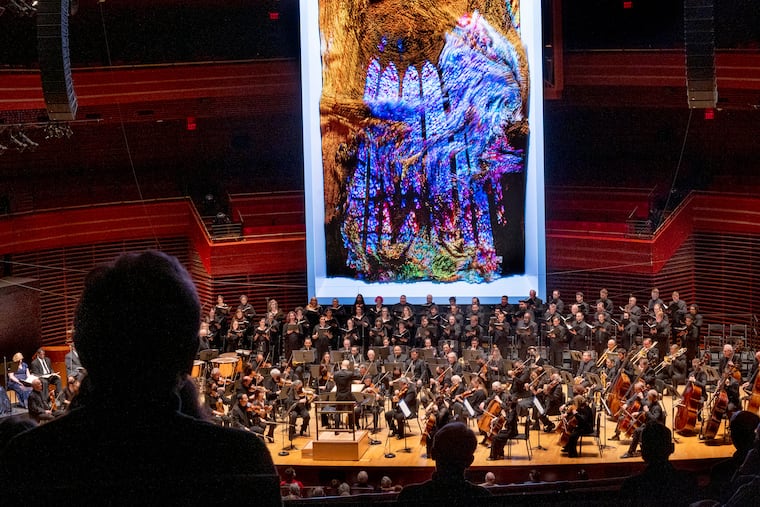Beethoven and data visualization — or, when bad things happen to great composers in Philly
Can Beethoven dream? The Philadelphia Orchestra set out to enhance genius with AI.

Yes, it was something of an artistic disaster. And yes, a performance of one of the most stirring and enigmatic works in the repertoire emerged terribly marred.
But the Philadelphia Orchestra’s visually enhanced Beethoven Missa solemnis Thursday night also served as a critical reminder: Art not only deserves a chance to fail — it needs to fail, at least once in a while. The research and development wing of most of the artistic establishment is undernourished. Epic fails are the cost of doing business if art is to thrive and move forward. Try, fail, and learn.
Failure Thursday came in two forms. Quite planned was the visual element. The orchestra commissioned artist Refik Anadol to create a spontaneous computerized response to the performance. On a tall, rectangular screen suspended above the stage, a series of animated images morphed to the Missa solemnis. It was silly and irritating.
The more objectively unfortunate aspect to Thursday’s performance won’t have to be faced by this weekend’s audiences (with any luck). A few minutes into the opening “Kyrie,” a series of electronic speaker “pops” reverberated throughout Verizon Hall. Yannick Nézet-Séguin stopped conducting. He walked off stage and returned a few minutes later, apologizing and starting at the top.
Later, in the gorgeously strange and diaphanous “Credo,” came another disruption. This time, the errant electronic sound was more like a heavy-metal riff. Nézet-Séguin stopped again. He stood for a while, and then resumed the piece.
The disruptions were avoidable. The popping sounds were apparent even while the orchestra was still assembling on stage. Someone should have fixed it then.
An orchestra spokesperson said the electronic outbursts were caused by a power surge in a dormant sound system, “most likely related to the storm this evening.”
The rest of the performance went on without interruption, but the damage had been done. A large part of the experience of the Missa solemnis is that the musical language is such a wonderful violation of norms that it creates a spell that delivers you somewhere beyond. That couldn’t happen here. The orchestra is offering any unhappy Thursday patrons free tickets to a weekend performance.
This orchestra, of course, has a long history of marrying images to sound, going back to Fantasia, and is to be applauded for trying to move the concept forward. But it was hard to find any artistic justification here. The Missa solemnis, for orchestra, chorus and four vocal soloists, is rarely performed. Though widely considered a masterpiece, it has been programmed by the orchestra only four other times since the ensemble’s founding in 1900. Underneath the distracting visuals was a fine performance struggling for attention
The screen above the musicians is large, bright, and high-definition — so much so that sometimes it looked sculpturally three-dimensional. Anadol created a database of 12 million images of buildings that “Beethoven could have encountered in Europe,” according to an article on the orchestra’s blog, and then used software allowing artificial intelligence to listen to the performance and “dream.”
When it comes to imagination, artificial intelligence has a long way to go. There were a few images of cathedrals, stained glass windows, or figures from artwork that came into focus. But for the most part, the swirling and shifting images were abstract. At one point, the computer animation looked like rabbit fur. At other times, vermicelli and fried rice came to mind. Only rarely did the visuals enhance the musical experience.
And so: why? Does the Missa solemnis need yet another layer of stimulus heaped upon it? When does a masterpiece benefit from a response from another artist? Why isn’t the music enough?
All of the technical tics and antics surely rattled the musicians, and yet they managed to soar. The orchestra assembled four vocal soloists whose sound and personalities blended and complemented each other — soprano Jennifer Rowley, mezzo Karen Cargill, tenor Rodrick Dixon, and bass-baritone Eric Owens. The Philadelphia Symphonic Choir, prepared by director Amanda Quist, had an impressive immediacy and vigor.
In molding both the orchestra and chorus, Nézet-Séguin often used short, dry note lengths, providing an appealing textural clarity that allowed for communication between musicians, even across the stage. Some of the instrumental doublings with voice or other instruments were exquisite, and no timpanist could have had a more sensitive ear for dynamics and color than Don S. Liuzzi.
Concertmaster David Kim did a beautiful job in the famously lovely section where the violin comes down from the heavens. At this point, I looked to the enormous screen for inspiration, some acknowledgment of the beauty unfolding in the music. Artificial intelligence just seemed to shrug its shoulders.
Additional performances: Saturday at 8 p.m. and Sunday at 2 p.m. Tickets are $10-$170. philorch.org, 215-893-1999.